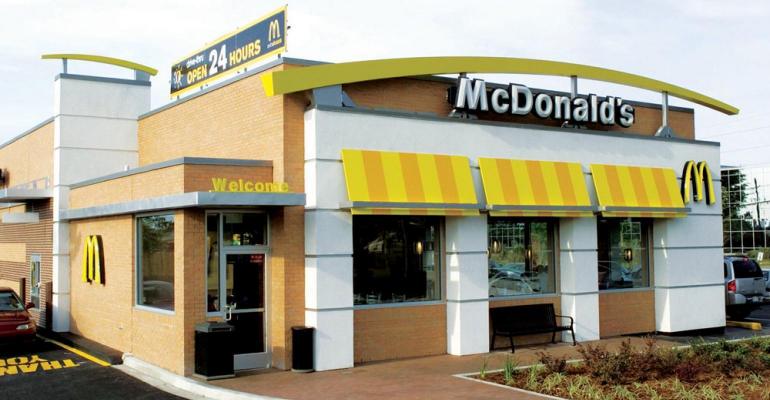McDonald’s Corp. executives said customers are showing some signs of trading down amid economic pressures, but the burger brand continues to see delivery continuing at an elevated pace.
The Chicago-based quick-service leader released earnings for the March 31-ended first quarter, posting positive same-store sales numbers despite economic uncertainty and the continuing conflict in the Ukraine.
McDonald’s suspended operations in Russia and the Ukraine in early March as a result of Russia’s attacks. The company said the quarter included costs of $27 million related to employee salaries, lease and supplier payments and $100 million for inventory in the company’s supply chain that it would likely need to dispose.
Geo-political and economic uncertainty have impacted consumers who are emerging from a two-year pandemic, said Kevin Ozan, McDonald’s chief financial officer.
“We've seen average check come down a little bit,” said Chris Kempczinski, McDonald’s CEO, on an earning call with analysts, “as perhaps you're seeing those large groups that were going out and ordering in the pandemic, you might be seeing some of that splintering where it's breaking up into two transactions, which was maybe previously one transaction.
“And then we are seeing also that at certain parts of the business and in certain geographies there is a little bit of a trade down that we're seeing that we're just keeping an eye on,” Kempczinski added.
Ozan said McDonald’s continued to feel good about the U.S. business and confident about the chain’s performance heading into second quarter.
“Consumers are definitely worried about inflation,” he said. “There's no doubt about that. They're concerned about energy and gas prices. But right now – and we are keeping certainly a close watch on lower-end consumers, just to make sure that we're still providing the right value for our lower-end consumers. But one of the things that's probably helpful right now as you know is food at home is even – has been increasing even more than food away from home. So that's probably been a little benefit to us also.”
McDonald’s expects its commodity and paper inflation to be 12% to 14% for the year after forecasting last quarter that it might rise 8%.
“Obviously, the landscape is changing pretty rapidly so we'll need to keep a close eye on that but that certainly increased substantially,” Ozan said, saying food and paper inflation has increased in part because of the Russia-Ukraine crisis.
“On the labor side, in the U.S. it's probably over 10% right now,” he said. “Part of that is because you'll recall that we made adjustments to our wages in our company-owned restaurants midyear last year, so we haven't lapped that so part of it is due to that and part of it is due to just continued wage inflation.
The first quarter increase in menu prices was about 8% with a roughly 70% flow-through has yielded about 5.5% in price increases, he said.
McDonald’s has seen delivery percentages to be slightly higher in Europe than in the United States, probably because of the lower percentage of drive-thrus on that continent.
But digital sales, especially through the loyalty program, show signs of taking hold in the McDonald’s system.
“Coming into this year we had introduced MyMcDonald's Rewards in over 40 markets including France, the U.S., Germany and Canada,” Kempczinski said. “Australia just launched in March and the U.K. will be go live later this year. Enrollment and participation are exceeding expectations. After just nine months in the U.S., for instance, there are more than 26 million loyalty members earning rewards.”
In McDonald’s Top Six markets, digital sales, which include mobile app, kiosk and delivery, made up more than 30% of systemwide sales in the first quarter, executives said. “This equates to nearly 60% growth over the past year,” Kempczinski said. “We did over $2 billion of digital sales in the U.S. alone in the first quarter. One of the biggest drivers of our digital adoption is our global loyalty program, MyMcDonald's Rewards. It's helping us better meet our customers' needs as we build more authentic and personal relationships”
Digital changes everything about the business, he added.
“Today I don't know 90% plus of the customers, 90% of the customers coming into my restaurant. I don't know who they are. I don't know their prior purchase. I don't know what their buying pattern is. I don't know are they a deal seeker, are they someone who always orders the same thing, do they like to try new things?” Kempczinski asked. “As I get better visibility into that customer, I can actually track and identify their preferences over time.”
Kempczinski said that with that knowledge the restaurants can give an improved experience.
“I'm going to be able to give them faster speed of service. I'm going to be able to give them a cleaner app, a cleaner menu board and I'm going to be able to give them deals, offers, programs that are more personalized to what they're looking for,” he said. “It's not going to necessarily be a one-size-fits-all type of thing. It's going to be much more bespoke to what each customer is looking for.”
For the first quarter ended March 31, McDonald’s reported net income was down 28% to $1.104 billion, or $1.48 a share, compared to $1.537 billion, or $2.05, in the same period a year ago. Revenues increased 11% to $5.666 billion from $5.125 billion in the prior-year quarter.
Same-store sales were up 11.8% systemwide and up 3.5% in the United States.
McDonald’s has more than 40,000 locations in more than 100 countries, with about 93% of its system franchised.
Contact Ron Ruggless at [email protected]
Follow him on Twitter: @RonRuggless

